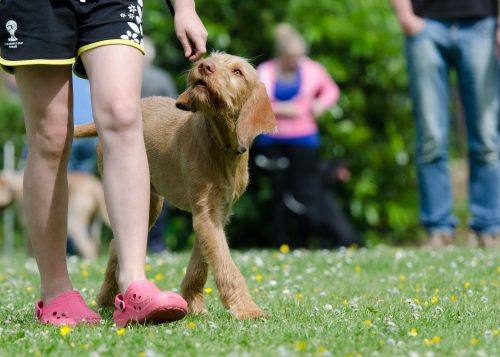Are you thinking about adopting a deaf dog and worried about the training process? Dogs that are deaf are teachable and can learn just like dogs with perfect hearing. When you reward good behaviors, dogs learn to do those behaviors more often. When your pup learns that poor behaviors don’t get him the desired response, those poor behaviors are greatly reduced or eradicated entirely.
Voice cues and commands won’t be an option with a deaf dog, but there are many visual and hand signals you can teach your dog, as well as ‘touch’ cues. These cues can be used to train your dog in manners and obedience, as well as tricks.
Causes of Deafness in Canines
The cause of deafness in young dogs may often be the result of a congenital defect that they were born with.
Deafness can also present in dogs who suffer from frequent and chronic ear infections, dogs that suffer from drug toxicity, and dogs that suffer from old age. Extremely loud and repetitive noises can cause an injury to your dog’s ears, resulting in hearing loss as well.
Dogs can become either partially deaf or fully deaf. Dogs who are born deaf don’t really understand what they are missing, and dogs that become deaf later in life tend to adapt very well.
Risk Factors for Deaf Dogs
According to one source, there are upwards of 89 breeds of dogs that suffer from congenital deafness, with some breeds experiencing a much higher occurrence than others. Dalmatians possess the highest risk, with around 30% of pups being born with a defect in one ear or both.
Other breeds that are known to have an increased risk of being or becoming deaf include:
- Australian Cattle Dogs
- English Setters
- Bull Terriers
- Parson Russell Terriers
- Whippets
- Catahoula Leopards
- Maltese’s
- Toy Poodles
- Miniature Poodles
- West Highland White Terriers
- Cocker Spaniels
Deafness seems to be more common in dogs that have mostly white heads. However, this is not true of all dogs, because some dogs that are solid white seem to have no issues with hearing at all.
It is thought that due to of a lack of pigmentation on the head, there is also a failure to develop pigment cells in the inner ear, or there is a complete lack of pigment cells altogether. When a dog suffers from a lack of pigmentation cells, this results in the death of nerve cells that are necessary for hearing.
Signs Your Dog May Be Deaf
Hearing loss in dogs, if they are not born with the defect, can be progressive and develop slowly. A slow progression is often much harder to detect than a congenital defect your dog may be born with. Symptoms are sometimes obvious, but that’s not always the case.
Common signs of deafness in dogs:
- A noted lack of response when playing with toys that squeak.
- A noted difficulty in waking your pooch up.
- A noted lack of response to voice commands and noises when sleeping, such as whistling, clapping, or other sounds used to wake up your pup.
- May become startled or snappy when aroused from sleep.
- May become startled or snappy if your pup is touched from somewhere outside of his field of vision.
- A noted lack of response to sounds and voice commands when he is looking away from you and you are not in his line of sight.
- A marked decrease in normal activity levels.
- A dog that barks excessively, especially for the age and/or breed.
- Pups born deaf may display aggressiveness with siblings.
- A dog that is going deaf may present with unusual or exaggerated reactions to physical stimuli. The wind, physical touch, and even vibrations of the floor could trigger a reaction.
- Dogs that vocalize in an unusual sounding way.
- A dog with progressively harder hearing may show a decline in responding to voice commands or when name is called.
- Sometimes a dog may react with confusion, disorientation, anxiety, or agitation in circumstances that should be familiar.
Aggressiveness in Deaf Dogs
Aggressiveness in deaf dogs is largely a myth. Any and all dogs could react with aggression if startled. If you wake your dog up with a treat however, even if he is startled, he will soon begin to associate the ‘startled’ feeling with something good.
You can also stomp your feet or bump something when you approach, because your dog will feel the vibration in the floor and awaken with much less anxiety.
Simply practice desensitizing your dog to sudden touches and your pooch should be just fine. Remember to touch the same spot each time, as it becomes a cue. Eventually, your dog will realize that surprise touches equate to surprise treats and he will respond happily instead of aggressively.
Training Tips for Deaf Dogs
- Training a deaf dog takes commitment, time, and plenty of patience. Many people prefer to use hand signals pulled from American Sign Language to give their pup visual cues when their pup cannot hear verbal cues. Some pet owners will use a ‘thumbs up’ or ‘hand up’ in lieu of clicker training. You might find that your deaf dog surprises you as he is taught and trained in the art of sign language.
- Instead of learning verbal cues, your dog will learn to hone in on the hand signs you teach him, as well as your facial expressions and body language.
- It important to first start with basics, such as the hand signals for ‘come’, ‘down’, ‘sit’, ‘stay’, ‘no’, and ‘stop’. Once your dog has mastered these word signs, you can begin to add in new ones, such as ‘walk’, ‘car’, ‘toy’, ‘treat’, etc.
- Keep your dog on a leash if he is deaf. A fenced yard is excellent too, and if that’s not possible, connect your dog to a stake and lead line whenever he is outside. A tag that lets people know your dog is deaf should be mandatory, and bells attached to your dog’s collar are also a smart idea. That way when your dog is on the move, it will make it easier for you to find him, even if he’s out of sight.
- Use visual cues such as waving, stomping your foot, or pounding your fist on something to gain your dog’s attention when you need it. If you often let your dog outside after dark, you can also train him to come inside at the flicker of your porch light.
- Keep in mind that since your dog cannot hear the tone of your voice to figure out if you are happy with him or not, food rewards tend to be the best way to incentivize him. You can slowly taper off with as your pup gets older, but with young dogs especially, food rewards are very useful.
Common Hand Signals Used with Deaf Dogs
Finger Pointing
This signal is handy when you want your dog to go somewhere, you want to send him somewhere, or you want to teach him to fetch something.
Thumbs Up
This sign can be used in place of clicker training, since a deaf dog can’t hear the clicker. Just like with people, a ‘thumbs up’ means ‘yes’, ‘good job’, or some other equivalent word.
Finger Pointing Down
This signal is commonly used to teach a dog to lie down. It’s natural and easy to remember too, which is important with hand signs.
Stop Hand
This is where you hold your hand palm out, to teach your dog a cue to stop. Sometimes this cue may be used to teach a dog the ‘off’ command. You’ll have to choose which you use it for, because if you switch back and forth, you will only cause confusion.
Open Hand Down
This seems to be a pretty universal sign, and it instructs your dog to sit. Because it’s also a natural move, it’s easy to remember and dogs tend to learn it quickly.
‘Okay’ Finger Sign
You can use this sign in place of a thumbs up to indicate ‘yes’ or ‘good’ to your dog. Just remember that facial expressions are important, so make sure yours is happy when accompanied by this sign, so that your dog knows he is pleasing you.
Hand Out, Palm Up
You can use this sign to tell your dog to come or to bring you his toy. It is also often used as a cue for teaching a dog to shake paws.
Two Fingers Pointing at Your Eyes
This is a gesture that you can use to teach your dog to make eye contact and watch you.
The ‘Call Me’ Sign
This is an alternative cue that you can use to teach your dog to watch you or keep eye contact. This one is useful because it’s a little bit different from the norm. This makes it stand out so your dog finds the cue easier to learn.
Clapping
This is one sign you may want to teach your dog right away because it’s also universal and easy to remember. The goal is to communicate that clapping your hands means ‘good job’, so your dog knows that whatever he is doing, you approve. Practice this cue often, and make sure you smile while doing it so your dog doesn’t get confused.
Deaf dogs that have been thoroughly trained can learn up to 50 or more hand signs and visible cues. Teaching your dog sign language can be both extremely rewarding and an excellent method of communicating with your pup.
Additional Tips for Training Your Deaf Dog
- Always have a leash with you, even if you don’t use it. Using it will come down to a personal choice, but allowing your dog to roam unleashed can be dangerous for your dog and others. This is especially true if other animals tend to get your pet excited. It’s easy for your pup to become distracted and take off in the heat of the moment, winding up lost or in harm’s way.
- If you do intend to let your dog off his leash, make sure you have rigged his collar with a loud bell and shiny little I.D. tag, that has your home phone number on it.
- Make sure you teach your dog to keep his eyes on you and check in frequently if he doesn’t already do it naturally.
- Keep your cues distinct so your dog doesn’t get each sign mixed up. If your cues all look very similar, it can be easy for your dog to become confused, especially if you have taught him a lot of cues over time. You may need to get creative in this regard. Keep the cues natural and easy to remember, especially with those you use frequently.
- Be conscious of your body language. Remember that deaf dogs are experts when it comes to reading your body and the cues you are transmitting. You need to pay special attention to what your body may silently be saying during the time you spend with your pet, as he could think you are communicating a cue that you didn’t intend to communicate. Even the slightest of body cues can speak loudly to your dog, so pay attention close attention to this.
- Always make sure your dog knows where you are and when you leave a room. Otherwise you could inadvertently create separation anxiety If you leave your deaf dog somewhere while he is asleep, and he wakes up and you are nowhere to be found, he may get nervous or fearful.
- Finally, if your dog develops a hearing problem that progresses over time, remember that his training and the adjustment period may take longer.
At the end of the day, it’s important to remember that deaf dogs can have just as good of a life as dogs who have full hearing capabilities. Your pup just may require a little extra dose of love, patience, and care.








